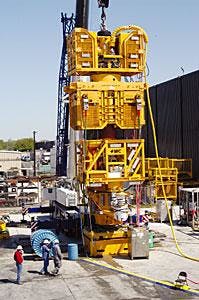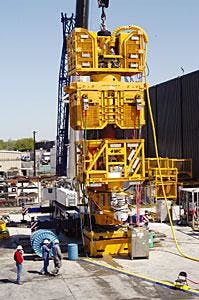FMC Technology Inc.'s Energy Systems unit, Houston, recently completed testing the first subsea tree for BP PLC's Thunder Horse development in the Gulf of Mexico, Mississippi Canyon Block 822. BP is operator and holds a 75% working interest in the field that lies in 5,600-6,500 ft of water.
Thunder Horse is one of the fields that will be connected to BP's Mardi Gras transportation system, currently under construction. (An overview of the Mardi Gras system begins on p. 84.)
FMC says the subsea system is designed for high pressure and temperature (HP/HT) service and is rated for 350° F. and 15,000 psi.
As of April 2003, it says BP has ordered 18 subsea trees with the first to be installed in 2003.
The photo shows the 42.5 ft high, 406,500-lb system integration test stack that from top down includes:
- Emergency disconnect package.
- Lower riser package.
- 13 ft.3.13 ft.3.13 ft, 101,000 lb, vertical subsea tree.
- Tubinghead spool.
- Test stump.
BP's $250 million contract with FMC Energy Systems calls for FMC to provide subsea trees, controls, manifolds, well connection systems, and related offshore services for Thunder Horse and other BP Gulf of Mexico developments.
BP has announced that the field development includes the largest production-drilling-quarters (PDQ) dynamically positioned semisubmersible in the world.
It says the platform will weigh more than 50,000 tons and is designed to process 250,000 bo/d and 200 MMcfd of gas. It expects first oil production in 2005.



